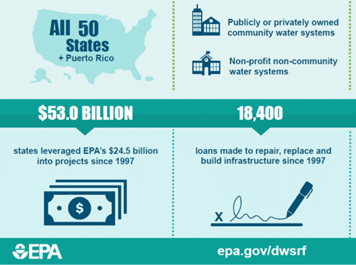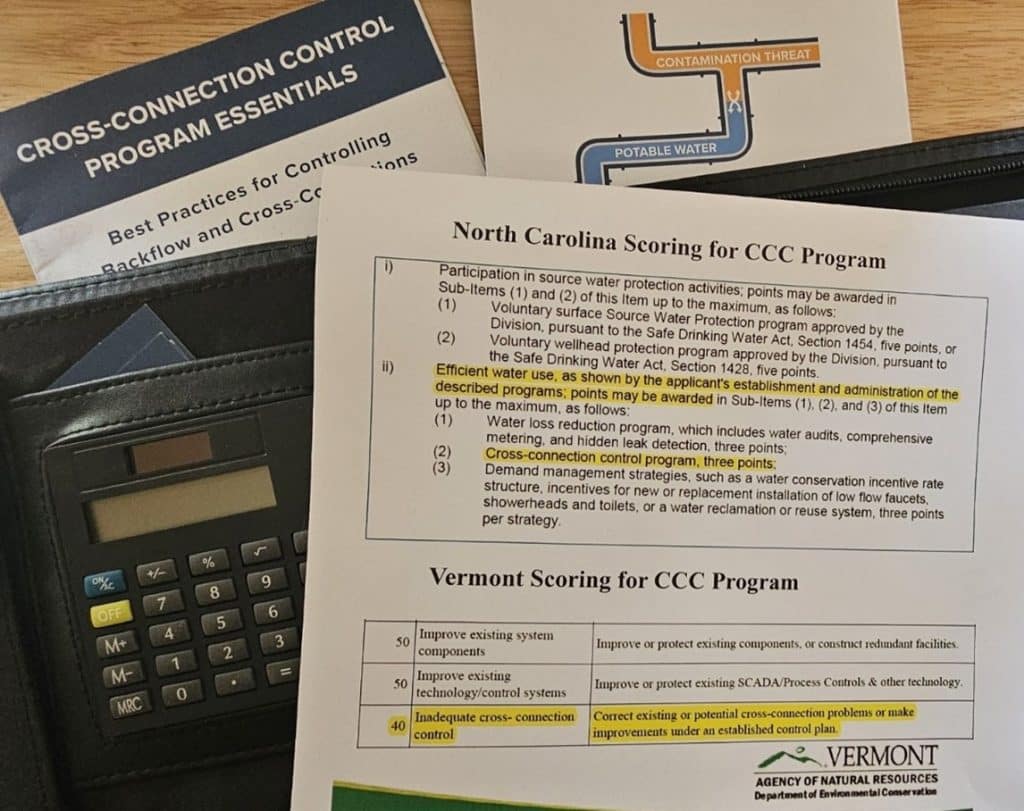Note: This article is not suggesting DWSRF grants will apply to Cross-Connection Control Programs, rather, having a well-documented and state-compliant Cross-Connection Control Program and affect your grant application scoring in some states.
Understanding the critical relationship between DWSRF grant scoring and potential cross-connection control program questions is essential for public water systems looking to secure DWSRF funding opportunities. A well-maintained cross-connection control program can significantly improve your DWSRF grant application score by demonstrating your commitment to water safety and regulatory compliance. Many states now consider the effectiveness of these programs in their grant evaluation criteria, with potential point deductions of up to 50 points for inadequate measures, directly impacting your ability to take full advantage of DWSRF funding opportunities.
Under the DWSRF, the EPA provides grants to all 50 states plus Puerto Rico to capitalize state DWSRF loan programs. The states contribute an additional 20% to match the federal grants. These funds are crucial for financing public water system improvements across the United States, supporting projects such as treatment plant upgrades, distribution system improvements, and source water protection .
However, many states have integrated additional factors into their grant application scoring process to ensure comprehensive water safety. One such factor is the evaluation of a public water system’s cross-connection control program.

Cross-Connection Control Programs: The Essentials
The Role of Cross-Connection Control in DWSRF Grant Scoring
With the growing emphasis on water safety and public health, cross-connection control programs that are mandated by state administration codes are becoming a critical component in DWSRF grant scoring. These programs not only help prevent contamination and backflow but also serve as a benchmark for the overall safety and reliability of a public water system. As states adopt more stringent criteria, demonstrating a strong cross-connection control program can significantly increase your grant application’s competitive edge.
Undetected cross-connections in a water distribution system pose significant risks of contamination and backflow, potentially leading to public health crises. A compliant and robust cross-connection control program is crucial not only for protecting water quality but also for improving DWSRF grant scoring when applicable. By demonstrating a commitment to protecting potable water from backflow hazards, public water systems can enhance their funding applications. Recognizing this, some states have begun to include specific questions about cross-connection control programs within their DWSRF application scoring process. These questions contribute to the overall score of the application, reflecting the system’s commitment to water safety.
Key Questions on Cross-Connection Control That Impact DWSRF Grant Scoring
When preparing your DWSRF grant application, keep these key cross-connection control questions in mind, as they could significantly impact your grant score.
- Does the public water system have an active cross-connection control program? Points = 10
This question assesses whether the public water system has implemented an ongoing program to manage and mitigate cross-connections. An active program typically involves regular inspections, public education, and enforcement of backflow prevention measures. A positive response reflects the system’s proactive approach to maintaining water quality. - Does the water system administer and enforce a cross-connection control program? Points = 3
This question evaluates the effectiveness of the program’s administration and enforcement. It looks at the ability to ensure compliance among consumers, maintain records of inspections, and take corrective action when necessary. Points are awarded for demonstrated enforcement capabilities, indicating the system’s commitment to public health. - Inadequate cross-connection control program Y/N? Points = 50
This question addresses where a cross-connection control program is deemed inadequate or insufficient. A significant point deduction reflects the high risk associated with poor cross-connection management, signaling to funding bodies the need for immediate improvements in this area. - Established Cross-Connection Control Plan/Policy Document? Points = 3
This question asks whether the public water system has developed a formal plan for cross-connection control. A well-documented plan outlines strategies and actions to prevent contamination, such as installing backflow preventers, regular inspections, and public outreach. Points are awarded to systems that have a clear, actionable plan in place.

Maximizing Your DWSRF Grant Score: Best Practices for Cross-Connection Control
The inclusion of cross-connection control program questions in DWSRF application scoring underscores the importance of safeguarding public water supplies from contamination risks. Public water systems with active, well-administered cross-connection control programs not only demonstrate their commitment to public health but may also optimize their DWSRF grant score and improve their grant application outcomes in the competitive process for DWSRF funding.
As states continue to refine their scoring methodologies, it is likely the emphasis on comprehensive water safety measures, including cross-connection control, will only increase. Public water systems aiming for DWSRF funding should ensure their cross-connection control programs are compliant, robust, effective, and well-documented to maximize their chances of securing financial support for critical infrastructure projects.
Conclusion
In summary, a comprehensive cross-connection control program not only safeguards public health but also enhances your chances of securing DWSRF funding by helping to optimize your DWSRF grant score and improve your grant application outcomes. By fully understanding the grant scoring criteria and proactively addressing any potential weaknesses, your public water system can be better positioned for success and sustainability.
Don’t risk losing points on your DWSRF grant scoring. Make sure your cross-connection control program is robust and state-compliant to maximize your funding potential. Contact HydroCorp today for a free consultation on how to enhance your grant application score through effective cross-connection control.


